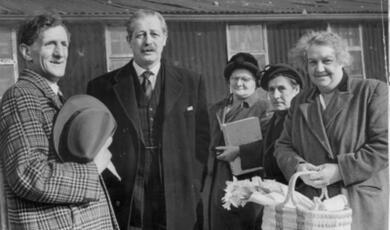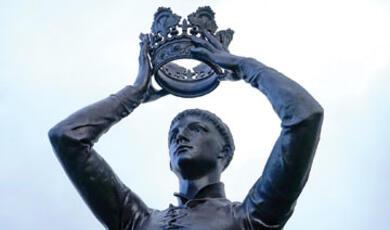22 June 2011
Tudor Health Reform
Introduction
Professor Tim Connell
Welcome to today’s Symposium on Tudor Hospitals, a fascinating subject which, oddly enough, has certain resonances with NHS reforms today. Let’s begin with an overview of public health in the Tudor period:
It is actually quite a popular subject these days, taught at both Key Stage 2 and GCSE. The common view is one of dirt, disease and death, bound down by superstition, quack remedies and bizarre medicines, all of which contains an element of truth, although there are more positive points and good news stories than might at first meet the eye.
Childbirth and infancy
If we focus on the human condition, a key experience (for all concerned) was childbirth and infancy. The population of The British Isles grows in this period, and nowhere more so than in London, which between the birth of Henry VIII in 1509 and the death of Elizabeth in 1603 grows from 90,000 to a quarter of a million. Inheritance and succession are of critical importance from titles and great estates to even quite ordinary trades. There are few greater examples of this than the redoubtable Elizabeth Pickering Jackson Redman Cholmeley – who in the 1530s and 40s married no fewer than three members of the Stationers’ Company (though not at the same time, of course) and who went on to become a successful printer in her own right – the first woman in fact known to be a printer.[i] Families were large, though mortality rates were high, even amongst the great families. No fewer than three queens died giving birth to future kings (Henry V, Henry VIII and Edward VI).[ii] The service for the Churching of Women in the Book of Common Prayer refers to the “great pain and peril of childbirth” which is reflected in the high death rates to be seen in the lying-in hospitals of the next century and beyond. Even 150 years later in Tristram Shandy, (most of which revolves around the author’s birth) his father Mr Walter Shandy is prone to philosophising, whereas My Uncle Toby (surely one of the kindest figures in English literature) takes a rather more practical view:
Of all the riddles of a married life, said my father, crossing the landing in order to set his back against the wall, whilst he propounded it to my uncle Toby—of all the puzzling riddles, said he, in a marriage state,—of which you may trust me, brother Toby, there are more asses loads than all Job's stock of asses could have carried—there is not one that has more intricacies in it than this—that from the very moment the mistress of the house is brought to bed, every female in it, from my lady's gentlewoman down to the cinder-wench, becomes an inch taller for it; and give themselves more airs upon that single inch, than all their other inches put together.
I think rather, replied my uncle Toby, that 'tis we who sink an inch lower.—If I meet but a woman with child—I do it.—'Tis a heavy tax upon that half of our fellow-creatures, brother Shandy, said my uncle Toby—'Tis a piteous burden upon 'em, continued he, shaking his head—Yes, yes, 'tis a painful thing—said my father, shaking his head too—but certainly since shaking of heads came into fashion, never did two heads shake together, in concert, from two such different springs.[iii]
In real life, Parson Woodforde’s remarkable diary of Eighteenth century life in Norfolk recounts in some detail the case of the Squire’s lady Mrs Custance. She had eleven children in twelve years, and was left virtually crippled by the last confinement. Three of the children died in infancy, although three lived into their eighties, and two into their nineties, an interesting reflection on the increase in longevity into the Nineteenth century.[iv]
The death rate among women of childbearing age seems to have been near epidemic levels, which must have led to other issues such as care of surviving children and disruption to the home economy and indeed whole families. I find it hard to believe that people faced such levels of human tragedy with nothing more than fatal resignation and, pious though people undoubtedly were, the comfort of religion must have been bleak in the face of it. The burial service reminds us that in the midst of life we are in death and people in Tudor times must have been acutely aware of that. If we take the example of Henry VII, he had lost his son and heir Prince Arthur who died in April 1502, his wife died in childbirth less than a year later in February 1503, and the baby did not survive either. Apart from any personal feelings, there were dynastic issues to take into account, although Henry in the end did not re-marry. But if this was the experience of the monarch, how must his subjects have fared, from the lady’s gentlewoman down to the cinder wench? At the other end of the Tudor-Stuart spectrum almost one hundred years later, there is Queen Anne: she went through eighteen pregnancies, of which thirteen were miscarriages or stillbirths; four children died before the age of two, and one died at the age of eleven.[v] Again there were dynastic implications, with the Crown passing subsequently to the German Georges and the Hanoverians, but the constant suffering of the poor Queen can hardly be over-stated.
Disease
With regard to disease specifically in Tudor times, there was no lack of choice when it came to things to die of, ranging from dysentery and typhoid to malaria, smallpox and leprosy – and that was just the fate of the kings of England.[vi]
There were all sorts of epidemics, not least of which was the sweating sickness, which has never been precisely identified, but which had a devastating effect on the population. It also killed Prince Arthur, heir to Henry VII, and nearly killed his young wife Catherine of Aragon. To quote the Bard:
Let us sit upon the ground
And tell sad stories of the death of kings;
How some have been deposed; some slain in war,
Some haunted by the ghosts they have deposed;
Some poison'd by their wives: some sleeping kill'd;
All murder'd: for within the hollow crown
That rounds the mortal temples of a king
Keeps Death his court.[vii]
Or to put it more prosaically, two English monarchs died of dysentery (Edward I and Henry V) and two of TB (Edward VI and possibly James I); Henry IV Part I may have had leprosy (though some people think that Henry IV Part II had psoriasis and actually died of something else); Edward III had a stroke; Mary died of ovarian cancer, and only Henry VII and Elizabeth appear to have died from natural causes and old age. And curiously enough, relatively few princes succeeded their father to the throne: the Black Prince may have had multiple sclerosis; Henry VIII’s illegitimate son Henry Fitzroy had TB; and Prince Henry, the highly promising son of James I, died of typhoid.[viii] The course of history would undoubtedly have been different had any of these survived to take the crown.
Leprosy, as we shall hear, was a sufficient threat for dedicated hospitals to be set up. And it had a high enough profile for some lazar hospitals to achieve notoriety, such as the one at Harbledown that pilgrims to Canterbury had to pass – and run the gauntlet of the inmates who wanted them to kiss a relic of St Thomas à Becket. (Erasmus himself commented on this practice with some disgust.)[ix]
Then there was the plague, which hit London in 1563, 1593, 1597 and 1603, killing tens of thousands of people in the process.[x] It affected all levels of society (Shakespeare actually lost three sisters and a brother to the disease)[xi] and caused a great deal of upheaval as people left London for lengthy periods of time if they could (or were allowed to). For ordinary people and lesser afflictions, there were the folk remedies, the wise woman with her knowledge of herbs, and housewives would have had their own remedies for family ailments. Many houses would have had a physic garden of the sort that the Barber Surgeons’ Company has today at their hall just near here.[xii]
Accidents and infirmity
Transport and travel were hazardous (Sir Thomas Gresham broke a leg by falling off a horse, and his only son, a promising youth aged 20, died in a similar way.)[xiii] Industrial accidents, not to mention occupational hazards, must have been common, with risks ranging from tetanus to septicaemia. There was only the vaguest notion of hygiene and public health was rudimentary, even though the City authorities did take the matter seriously.[xiv]
A great deal of human suffering lies behind all of the above. I am something of a renegade in all this. Did people really tolerate such apparent helplessness in the run-up to the Age of Reason? When Prince Octavius died in 1783 at the age of 4, King George III was so affected that he cried, “There will be no heaven for me if Octavius is not there”,[xv] echoing perhaps the great lament of King David, “would God I had died for thee, O Absalom, my son, my son!” And Absalom was far from being the perfect son…[xvi]
The elderly wealthy would not have been prepared to accept infirmity – and plenty of medical men (and especially the quacks and mountebanks) would not have wanted them to! There is ample evidence of bequests, legacies and endowments for hospitals or for the relief of suffering to show that people cared as much then as we do today with our donations to cancer or heart charities. Some of these early bequests have survived to this day, such as Trinity Hospital, which was founded by the Earl of Northampton in 1614, and is still managed by the Mercers Company.[xvii]
I would prefer to think that two key human characteristics came to the fore in the face of constant ongoing pain and personal tragedy: one is human compassion; the other is human ingenuity.
Not all at sea
I would like to take Medicine at Sea as an example. In the introduction to some symposia previously, I have unwittingly stolen the speakers’ thunder by inadvertently using the examples they were already going to draw on, so I hope that this topic will widen our perspectives without treading on anyone’s toes! Ships’ logs, memoirs and reports and the needs of a growing navy provide us with a fair amount of data;[xviii] there is an interesting literature as growing literacy leads to an increasing number of manuals and textbooks; and we even have the medicine chest that belonged to the surgeon on board the Mary Rose, not to mention sackfuls of bones belonging to many of his patients. Also of interest is the Giustiniani Medicine Chest, made in Genoa in c.1565. It holds 126 bottles and pots, some with traces of their original contents.[xix]
As England’s maritime power expanded and navigational skills grew, exploration began to spread across the globe, ranging from Sir Hugh Willoughby’s voyage to the North Cape and beyond in the 1550s, to Sir Martin Frobisher’s searches for the North-West Passage in the 1570s [xx] and Drake’s circumnavigation of the globe in 1577-1580. The problem lay not with the ships or navigational instruments (though measuring longitude was still a couple of centuries off) but the health of the crew, and scurvy in particular. An early voyage to the Spice Islands in 1610 saw four ships out of five stricken with scurvy, leaving the men too weak to work the ship.[xxi] The one exception was the ship whose crew had been issued with lemon juice. This might have been seen as the perfect Baconian experiment, only other remedies (including mustard) were still being tried and it was not until the Eighteenth Century that the scurvy was really brought under control.
Both sides during the Spanish Armada were seriously debilitated by disease, and the Spanish commander, the Duke of Medina Sidonia, was convinced that this was because of unhygienic conditions on board ship and the poor quality of the rations being served, which was probably true of both sides – Lord Howard of Effingham reported on 1 September 1588 that the crew on board some English ships were too weak to raise anchor.[xxii] The Armada even had a hospital ship in attendance, the Casa de Paz Grande (the Large House of Peace). Medical care at sea was a critical subject, as trained seamen were both valuable and scarce, especially in time of war. Oddly enough, the first medical textbook on surgery at sea was published in 1588 by William Clowes.[xxiii] John Banester, whose Anatomical Tables came out in 1581, had been chief surgeon with a voyage to the East Indies in 1582.
Medicine in print
Medical publishing overall is quite extensive in the Sixteenth century, though England tends to lag behind the Continent, so I will take two French examples to illustrate this: Ambroise Paré was born in 1510 and died in 1590 (no bad advert for a doctor at the time). He was royal physician to no fewer than four kings of France and, like so many other medics in the period, gained his surgical experience on the field of battle. He deserves to be remembered for a number of advances in medicine, ranging from ligature of the arteries in amputation (rather than cauterization) and the invention of the crow’s beak, used in a modified form in surgical procedures even today as the haemostat. Oddly enough, Ambroise Paré also made a major contribution to obstetrics, with the development of podal version, a technique to safely deliver a foetus in a transversal position. He also found time to write extensively and was translated into a number of languages.[xxiv]
The other interesting example is François Rabelais. Best known as the author of Gargantua and Pantagruel, he took holy orders in 1521, but petitioned the Pope to move from the Franciscan to the Benedictine order before going to Montpellier to study medicine. He took his doctorate in 1532 and became expert in syphilis, then a new and little understood disease, which was considered to be a new form of leprosy. He also lectured on surgery. He even invented a form of clamp to prevent broken limbs from shortening.
Final points
The Sixteenth Century is a time of change. The great mediaeval masters, Galen and Hippocrates, still hold sway and people believe in the four Humours and Astrology, and Tudor doctors would recognise the medical textbooks listed by Chaucer for his Doctor of Physic[xxv]. At the same time, medical knowledge is expanding as part of the Renaissance and a more recognisably scientific approach is becoming evident. Key figures emerge like Thomas Linacre, who brings back the New Learning from Italy, and is pivotal in the foundation of the original College of Physicians, established by a Royal Charter of 1518 from Henry VIII.[xxvi] The more traditional Barber Surgeons go back to at least 1308, and received their first charter in 1462 from Edward IV. The Barbers were confined to their traditional roles of bloodletting and tooth drawing in 1540 when the Worshipful Company of Barbers and Surgeons of London was founded by Act of Parliament, so there is evidence here of attempting to define the roles of different types of practitioner – and perhaps to take a more modern approach to the subject.[xxvii]
How hospitals are reformed and how medicine changes in the Tudor period is something that we shall hear about today.
Conclusion to Symposium
It is perhaps erroneous to focus on one particular period in the long march of Everyman in the face of illness, decline and death. Anthropologists report on the care of the sick and elderly in a wide range of cultures and archaeologists can show that the Neanderthals looked after handicapped children, could treat the injured and buried their dead with reverence. Tombs and memorials from mediaeval times to the high Victorians were certainly ornate, but would they really have been more concerned with the dead than the living? However, the Tudor period is interesting in that there is major social change with population growth, political change with the Reformation and the side effects arising from the dissolution of the monasteries, and the wider impact of printing and the dissemination of knowledge. We can also see the cross-over between superstition, traditionally-held beliefs and longstanding, if erroneous, ideas on the part of the medical profession, and the beginnings of modern science and intellectual enquiry. This meant that, until the advent of antiseptic procedures and anaesthesia, surgical techniques were moving ahead of what could practically be carried out if the patient was to survive.
It is surprising that diseases in the Tudor period appear to come and go, so that the needs of medicine were never quite the same over a century. The sweating sickness is extremely virulent, but is only around between 1485 and 1551; plague is a regular visitor, but does not recur after 1666; syphilis arrives with Columbus and the lads in 1493 and spread by a marauding army, hence its various names such as the Malady of France and the Neapolitan Disease; and, slightly later, rheumatoid arthritis becomes prevalent in the seventeenth century, and puerperal fever can reach epidemic proportions from the seventeenth to the nineteenth centuries.
The advance of medical knowledge also seems to go in fits and starts. Curettage for example, which would have significantly reduced death in childbed, was known to the Romans, but the surgical procedure did not re-appear until Joseph Récamier introduced it in the early Nineteenth century.
A great deal of medical knowledge did in fact survive in the Middle East, where medicine appears to have been more advanced in the Mediaeval period than in Europe. The sweep of intellectual curiosity and learning which leads us into the modern world can be traced to the fall of Constantinople in 1453 and the flight of scholars westwards, but a lot of this information also came into Europe via the School of Translators of Toledo in Spain, where a range of scholars, Arabs, Jews and Christians, worked between a range of languages, and had enormous influence. The Englishman Adelard of Bath, for example, became tutor to Henry II of England. Their work was disseminated widely, appearing in monastery and university libraries. The medical treatises of the Persian philosopher Avicenna, dating from 1025, were translated in the Twelfth century and became a standard university text in Europe until the mid-Seventeenth century.[xxviii]
New teaching materials, based on dissection and anatomical observation were beginning to be available. Andreas Vesalius, a Belgian who trained in Paris and taught in Padua (so a good all-round Renaissance man) produced his Fabric of the Human Body in 1543, based on executed criminals who (obligingly) were provided for him at regular intervals. His observation-based work was followed by contributions from such luminaries as Gabriele Fallopio and Bartolommeo Eustachio (you can work out for yourselves what they were observing...)[xxix], and subsequently from medical men as far apart as Spain and the Netherlands. In England Henry VIII appointed the first Regius Professor of Physic at Cambridge in 1540, followed by Oxford in 1546, which is indicative of a more modern and systematic approach to a traditional university subject.
So although Thomas Gresham’s Chair of Physic comes a bit later in 1597, Gresham College, and its offshoot the Royal Society, can take at least some of the credit (if not the reflected glory) for the move towards rational thought, the development of experimental scientific methods and the dissemination of the New Learning, something which I hope we have been able to contribute to today.
©Professor Tim Connell, 2011
[i]See http://www.thefreelibrary.com/Elizabeth+Pickering%3A+the+first+woman+to+print+law+books+in+England...-a0113649041
[ii]As did Katherine Parr in 1548 and Princess Charlotte in 1817. See http://en.wikipedia.org/wiki/List_of_women_who_died_in_childbirth#United_Kingdom
[iii]Tristram Shandy Volume 4 (1761) Chapter 12. (Penguin p.285.)
[iv]See the Folio Society’s 1992 edition of Parson Woodforde’s diary pages 324 and 438. The children were born between 1779 and 1791.
[v]Queen Anne’s husband was Prince George of Denmark.
[vi]For more on regal mortality, see Michael Evans (2003) The death of Kings: royal deaths in mediaeval England, Hambledon Continuuum
[vii]Richard IIAct III sc.2.
[viii]As did Prince Albert in 1861. And to round off the list, Oliver Cromwell, of course, died of malaria in 1658.
[ix]For more on leprosy see Carol Rawcliffe (2006) Leprosy in Mediaeval England, Boydell.
[x]See P Slack (1985) The impact of plague in Tudorand Stuart England, RKP. Shakespeare actually lost three sisters and a brother to the disease: http://www.william-shakespeare.org.uk/bubonic-plague-shakespeare.htm
[xi]http://www.william-shakespeare.org.uk/bubonic-plague-shakespeare.htm
[xii]For details of the physic garden and the traditional curative properties of plants, see http://www.barberscompany.org/herb%20garden.html
[xiii]King William III also died after falling from a horse in 1702. It stumbled on a molehill, hence the Jacobite toast to “the little gentleman in black velvet”. Note that his wife, Queen Mary, had died of smallpox in 1694.
[xiv]See the Museum of London displays in the Medieval and War, Plague and Fire galleries. “Declining Loos of London” is a current exhibition at the Museum, complaining about the fact that the number of public conveniences even today has not kept pace with the growth and movement of population.
See http://www.mymuseumoflondon.org.uk/blogs/blog/declining-loos-of-london-by-paula-simoes/
[xv]Five of the fifteen children of King George III and Queen Charlotte died in infancy. Octavius (logically enough) was the eighth child – and the third to die. See http://www.englishmonarchs.co.uk/hanover_3.htm
[xvi]See 2 Samuel 14 – 18, verse 33 in particular. Absalom not only violated his half-sister Tamar, but also led a revolt against his father.
[xvii]See http://www.mercers.co.uk/netbuildpro/process/224/EarlofNorthamptonsCharity.php. Note that “hospital” is not used in its modern sense, but more as a home for the poor, elderly or infirm.
Robert Kitchin’s charity at the Saddlers dates back to 1556: http://www.saddlersco.co.uk/thesaddlerscompany/charitable_activities.html#KitchinsCharity
[xviii]Ships’ surgeons’ reports from 1793 to 1880 have now been digitised by the National Archives and are to be found on-line at http://www.nationalarchives.gov.uk/surgeonsatsea/
[xix]The chest from the Mary Rose is in the museum in Portsmouth. The Giustiniani Chest is now in the Science Museum. (The Giustinianis were a major Genoese family.) See http://www.ncbi.nlm.nih.gov/pmc/articles/PMC1139191/pdf/medhist00086-0104.pdf for a full description.
[xx]Sir Martin Frobisher is buried in the church of St Giles without Cripplegate
[xxi]The admiral was James Lancaster. See Nathaniel’s Nutmeg by Giles Milton (Sceptre 1999) page 79.
[xxii]See chapter XI of Armada, the official catalogue of the 1988 exhibition held at the National Maritime Museum. After La Casa de Paz Grande foundered, the medical supplies were transferred to the San Pedro El Mayor and three Breton pinnaces, captured for that task.
[xxiii]A prooved practise for all young Chirurgians by Wm. Clowes (1544-1604). This was based on his service at sea and also as a military surgeon.
[xxiv]Paré’s treatise on midwifery appeared in English in 1612 under the title “Chylde Birth, or the Happy Deliveries of Women”.
For more on this remarkable man see http://www.comptonhistory.com/compton2/pare.htm
[xxv]In the Prologue to the Canterbury Tales. Folio edition 1978, page 28.
[xxvi]It became the Royal College of Physicians in 1674.
[xxvii]For more on the Barbers’ Company see J Kennedy Malling (2003)Discovering London’s Guilds and Liveries, Shire Publications.
[xxviii]See the Cambridge Illustrated History of the World’s Science 1983, pages 235 – 237.
[xxix]See the above, pages 285-288.


 Login
Login







